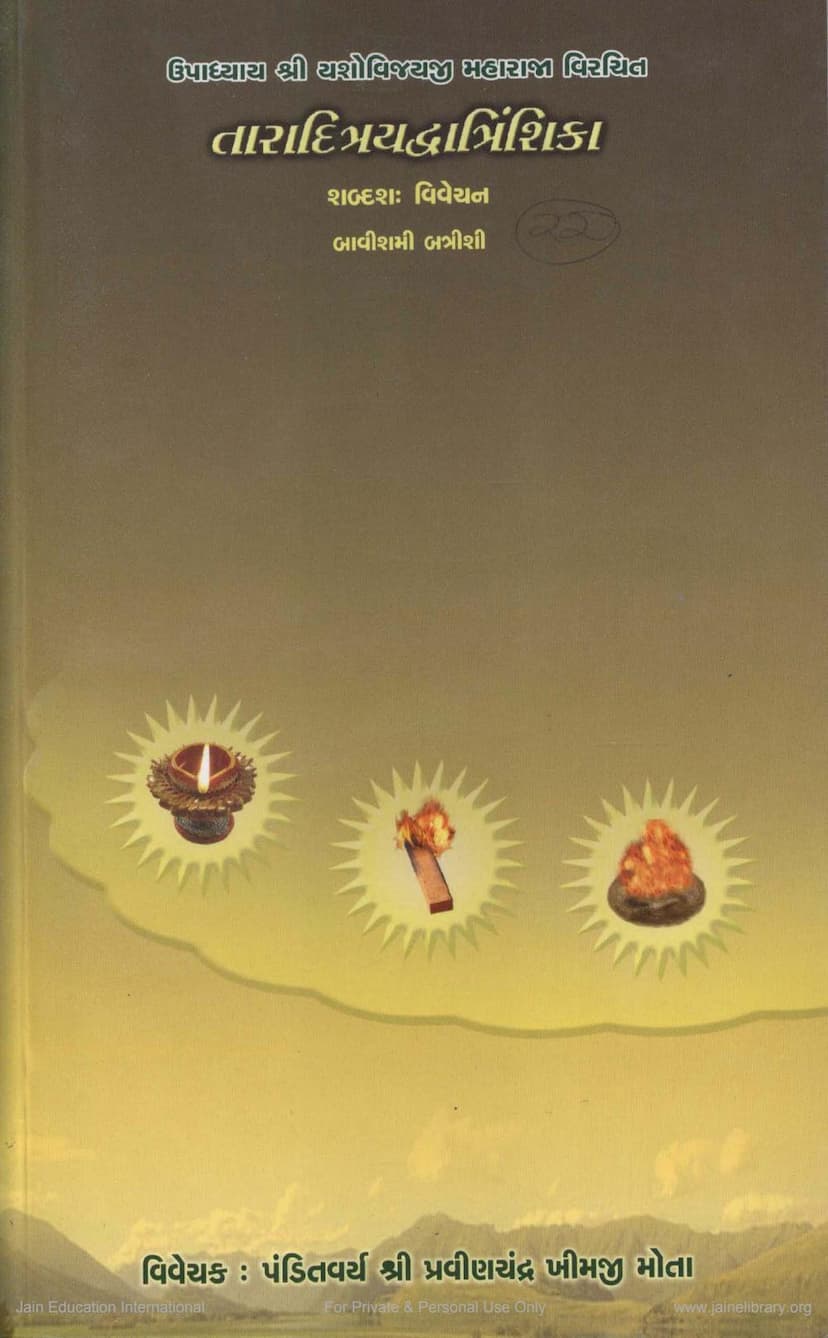Taraditraya Dvantrinshika
Added to library: September 2, 2025

Summary
This document is the introduction and partial text of the Jain text "Taraditraya Dvantrinshika" (તારાદિત્રયદ્વાત્રિંશિકા), which is part of the larger work "Dvātrinśadvātrinśikā" (દ્વાત્રિશદ્દ્વાત્રિશિકા) by Mahamahopadhyaya Shrimad Yashovijayji Maharaj. The provided text includes preliminary pages, an introductory note, the author's and commentators' details, and the beginning of the commentary on the text itself.
Here's a breakdown of the content:
- Title: Taraditraya Dvantrinshika (તારાદિત્રયદ્વાત્રિંશિકા)
- Author of the original text: Mahamahopadhyaya Shrimad Yashovijayji Maharaj (મહામહોપાધ્યાય શ્રીમદ્ યશોવિજયજી મહારાજા)
- Commentator (Vivechak): Pandit Varyashri Pravinchandra Khimji Mota (પંડિતવર્ય શ્રી પ્રવીણચંદ્ર ખીમજી મોતા)
- Publisher: Gitarth Ganga (ગીતાર્થ ગંગા)
- Subject: The text deals with spiritual progress and the stages of spiritual development within Jainism, specifically focusing on three "drishtis" (views or stages of perception): Taradrishți, Baladrishți, and Dipradrishti. These are part of a larger classification of eight spiritual stages.
- Key Figures Mentioned:
- Shrimad Yashovijayji Maharaj (Original author)
- Shrimad Haribhadrasurishwarji Maharaj (An earlier influential Jain scholar)
- Shrimad Vijay Ramchandrasurishwarji Maharaj (Patron/inspirer)
- Munipravar Shri Mohjitvijayji Maharaj (Lecturer whose talks are published by Gitarth Ganga)
- Ganivarya Shri Yugbhushanvijayji Maharaj (Lecturer whose talks are published by Gitarth Ganga, and also involved in compilation/research)
- Sadhviji Bodhiratnashriji (Disciple involved in compilation/research)
- Pandit Varyashri Pravinchandra Khimji Mota (Commentator)
- Publisher's Mission (Gitarth Ganga): The publisher's aim is to analyze and explain the profound philosophical elements found in Jain scriptures by ancient scholars. They aim to help the Jain community gain comprehensive knowledge of various subjects. They also publish lectures and commentaries by respected scholars.
- The "Taraditraya Dvantrinshika" itself:
- This is the 22nd chapter of the "Dvātrinśadvātrinśikā" by Yashovijayji Maharaj, which contains 32 chapters, each with 32 profound verses.
- The text focuses on three specific "drishtis" that represent stages of spiritual understanding before attaining Samyagdarshana (right faith/perception).
- Taradrishți: This stage is characterized by a slight clarification of the truth compared to the previous stage (Mitradrishti). It leads to the development of "Niyamas" (disciplines like purity, contentment, self-study, austerity, and devotion to the divine) and reduces "udvega" (anxiety or agitation) in performing beneficial actions. It also cultivates a desire to know more about the truth. The commentary compares the understanding at this stage to the pupil of the eye.
- Baladrishți: In this stage, the understanding of the truth is stronger, comparable to embers of a fire. It leads to the practice of "Sthirasukhasana" (stable and comfortable posture) and a strong desire to listen to the truth ("tatva-shushrūsha"). It also marks the absence of "kshepa" (distraction or mental wandering).
- Dipradrishti: This is the stage of strong understanding, like a burning flame. It involves efforts to increase virtuous states and eliminate negative states. It includes "bhava-prāṇāyāma" (internal regulation of mental energies) and a greater emphasis on Dharma (righteousness) than on life itself. This stage leads to "tatva-shravana" (listening to the truth) and is still characterized by the absence of "sūkṣmabodha" (subtle, refined understanding).
- Key Concepts Discussed in the Commentary:
- Niyamas (Disciplines): Shaucha (purity), Santosh (contentment), Swadhyaya (self-study), Tapa (austerity), Ishwarapranidhana (devotion to the divine).
- Shaucha (Purity): Explained as external purity (washing the body) and internal purity (purifying the mind through loving kindness, etc.). Its fruits include self-disgust, non-attachment to others, purity of being, cheerfulness, concentration, control of senses, and suitability for self-realization.
- Fruits of other Niyamas: Santosh leads to supreme happiness, Swadhyaya to seeing one's chosen deity, Tapa to mastery over the body and senses, and Ishwarapranidhana to Samadhi (deep concentration).
- Absence of "Ksḥepa" (Distraction): In Baladrishți, distraction is reduced, leading to skill in yogic practices.
- Significance of Shushrūshā (Eagerness to Listen): The text emphasizes that eagerness to listen to the truth is crucial for spiritual progress, comparing it to sowing seeds in fertile ground. Without it, scriptural study is futile.
- Prāṇāyāma (Breath Control): The text discusses physical Prāṇāyāma (rechaka, puraka, kumbhaka) as described in Patanjali's Yoga Sutras, but then contrasts it with the Jain perspective. In Jainism, Prāṇāyāma refers to the regulation of mental energies (bhava-prāṇāyāma) by dispelling negative emotions, cultivating positive ones, and stabilizing them. Physical Prāṇāyāma is considered less important or even discouraged in Jainism due to its potential to cause agitation.
- The Stages of Drishti: The commentary meticulously details the characteristics, practices, and fruits of each of the three drishtis, often referencing Patanjali's Yoga Sutras for parallel concepts.
- Avidya-samvedya-pada vs. Vidya-samvedya-pada: A significant theme is the distinction between "Avidya-samvedya-pada" (a state of incomplete or mistaken perception) and "Vidya-samvedya-pada" (a state of true and clear perception). The first four stages are characterized by Avidya-samvedya-pada, which hinders subtle understanding. The goal is to overcome this through Satsanga (company of the virtuous) and study of scriptures (Agama).
In essence, the document provides an in-depth analysis of the initial stages of spiritual practice as described by Yashovijayji, focusing on the gradual development of understanding, detachment, and dedication to the spiritual path, while also highlighting the limitations of these early stages and the path to overcoming them.